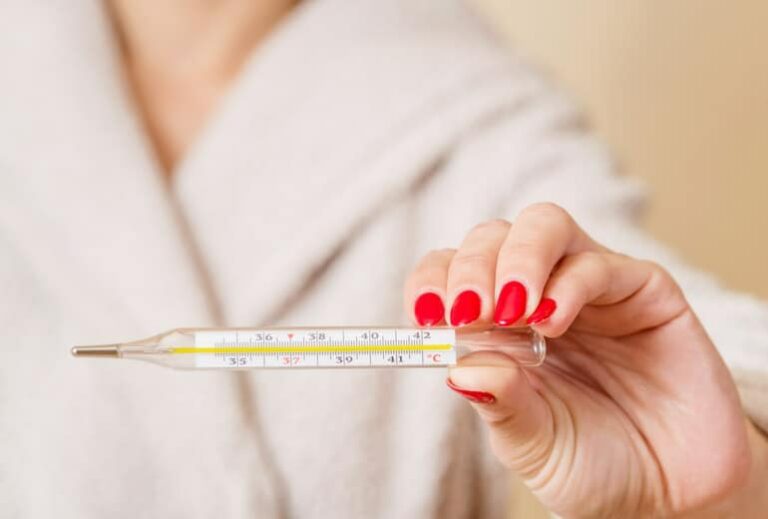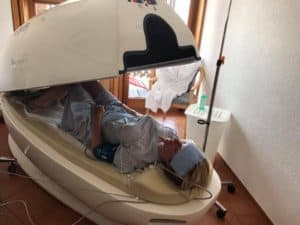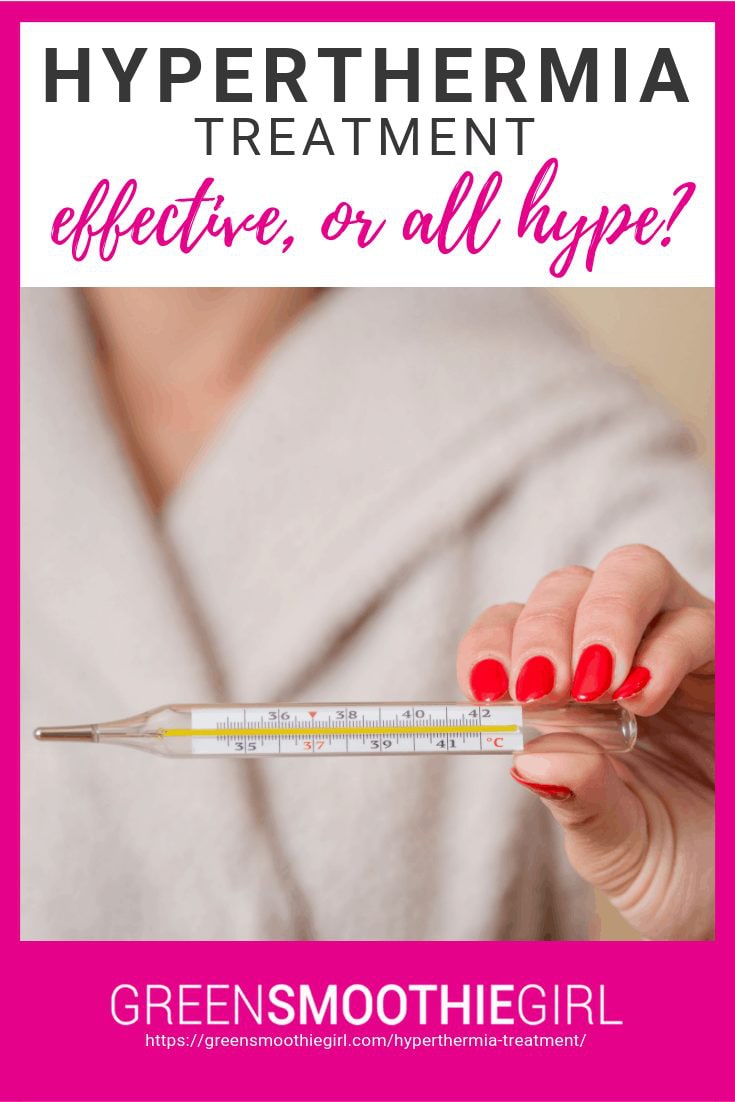Hyperthermia Treatment — Effective, or All Hype?

Hyperthermia (not to be confused with hypothermia) is an induced high fever.
A high fever—on purpose.
Don’t I have Tylenol for that? you might be thinking. And that skepticism makes sense. After all, in Western culture, most of us have a deep-seated fear of fevers. We’ve been taught to call the doctor and administer non-steroidal anti-inflammatories (NSAIDs) every few hours if our child’s fever (or our own) approaches 100.
A rising temperature fills us with terror, as we imagine our poor body spiraling out of control.

Fevers might be alarming, but they’re typically a sign that the immune system is doing its job.
Fortunately, the truth about fevers couldn’t be further from our fears. And hyperthermia, a functional medicine treatment that mimics a fever, shows tremendous promise for treating some truly fearful ailments and diseases—including cancer.
What Is Hyperthermia?
The word hyperthermia literally means “over temperature.”
And in some cases, the word is used to describe heat exhaustion or heat stroke, dangerous conditions that involve high body temperatures paired with dehydration and electrolyte loss.
Hyperthermia treatment, on the other hand, is a controlled, scientifically proven procedure that’s commonly used (and even covered by insurance) in conventional hospitals throughout Europe to treat cancer.
During full-body hyperthermia treatment, you lay inside a special chamber, closely monitored, while a physician increases your core body temperature to 102-104 degrees Fahrenheit over a period of 4-5 hours. An IV drip keeps your electrolyte and fluid levels at optimal levels.
So, what does a high temperature actually accomplish? It can be helpful to first understand the difference between fever and hyperthermia treatments.
Hyperthermia Vs. Fever
We all know that a normal human body temperature is 98.6 degrees Fahrenheit. That temperature is optimal for most of our cells. But what most don’t know is that immune cells (including white blood cells and “killer T” cells) are actually optimized between 100-104 degrees Fahrenheit.¹
That’s the real reason we run a fever when we get sick. The hypothalamus, the part of our brain that (among many other things) controls our core body temperature, actually raises our body temperature on purpose.

While they can be uncomfortable, elevated temperatures usually aren’t cause for concern.
What About Ibuprofen and Tylenol? (NSAIDs)
If fevers are so beneficial, why do we need NSAIDs (non-steroidal anti-inflammatories) like Tylenol and Ibuprofen?
In most cases, we don’t. Not only are NSAIDs dangerous (and responsible for an estimated 100,000 ER visits and 16,500 deaths per year²), but there are better ways to reduce pain and inflammation naturally. And when it comes to prematurely bringing down a fever, NSAIDs should almost never be used.
When we get sick, most of us mistakenly think that the virus has taken control to raise our body temperature (instead of our own internal temperature gauge), so we take Tylenol or Ibuprofen to fight back. In other words, we short-circuit our body’s built-in virus- and bacteria-fighting weapon.³
Most of the cells in our body can weather temperatures of 105-111 without sustaining damage. However, most viruses, bacteria, mold spores, and fungus spores are significantly weakened by temperature above 102, especially with our heat-actived killer T cells on the offensive.³
Common Uses and Benefits of Hyperthermia Treatment
As with water fasting for short lengths of time (another experiment I have done in my own health quest), the controlled heat from hyperthermia treatment puts the body’s immune system into a state of hormesis, or “healthy stress,” which triggers our immune cells to enter a “high alert mode” of sorts. And while many people who use hyperthermia treatments are very ill, an annual fever can also be a great preventative for those of us who are healthy, too.
Cancer Preventative and Damaged Cell Cleanup
The truth is, all of us have cancer. Every last one of us–to some degree. At any given moment, some of of the DNA in some of our cells has mutated because of damage, malnutrition, or a buildup of toxins and chemicals. As this damage compounds, especially in cells that are capable of multiplying rapidly, diagnosable cancer develops.
Full-body hyperthermia treatments can mobilize the immune system to attack and destroy precancerous and cancerous cells with damaged DNA that we’re not even aware we have. Many people (including myself) use hyperthermia treatments as yearly preventative care.
Mainstream doctors and hospitals in Europe use hyperthermia to optimize the therapeutic effects of chemotherapy, and to minimize the harm that these chemical treatments cause.
Eliminating Fungal and Yeast Infections
While getting rid of fungal and yeast infections might sound like a small win, this is actually a huge benefit. Many common ailments we suffer from (including digestive troubles, leaky gut syndrome, and chronic fatigue) can actually be traced back to yeast overgrowth in the gut, as a result of a highly processed diet and sugar, or of taking antibiotics and other medications.
One study even linked yeast infections to memory loss and mental illness.4
Fungus and yeast die at elevated body temperatures, so there may be clinical benefit for a host of diseases tied to yeast and fungus, for those willing to get in a hot box and sweat like they’ve never sweat before!
Cancer Therapy as an Adjunct to Chemotherapy
In Europe, hyperthermia treatments are commonly used alongside chemotherapy treatments5 for patients with cancer.

Hyperthermia treatment can be used in addition to other cancer treatments.
Several clinical studies confirm the effectiveness of hyperthermia combined with chemotherapy6 and/or radiation in shrinking tumors and improving survival rates for many different kinds of cancer7: melanoma, brain cancer, lung cancer, and breast cancer, as well as cancer of the neck, esophagus, bladder, liver, rectum, appendix, and cervix.
How Does Hyperthermia Help Treat Cancer?
Elevating the core body temperature weakens mutated cancer cells, allowing chemotherapy and radiation to work more effectively at a much lower dose.6 Since chemotherapy and radiation damages unhealthy and healthy tissue alike, lowering the dose is a huge win for cancer patients.
Some patients use hyperthermia treatments to battle cancer without chemotherapy or radiation; however, it’s difficult to pinpoint success rates. This ambiguity is partly because of Western medicine’s hyperfocus on surgery and drugs as the “standard of care,” which results in lack of funding for clinical trials that evaluate “alternative” treatments.
In addition, almost everyone who uses “alternative treatment” for cancer uses a shotgun approach, trying many different supplements, nutritional approaches, and alternative treatments, making it hard to isolate the effects of hyperthermia as part of that course of treatment.
What to Expect From Hyperthermia Treatment
Knowing what to expect from hyperthermia treatments in terms of experience, post-treatment, and costs can help you feel prepared and comfortable.
During Treatment
During whole-body hyperthermia, you’ll lie with your body inside a space-age looking pod / incubator, with your head exposed.
A rectal thermometer will allow the technicians to monitor your body temperature closely as it is raised to 102-104 degrees over the span of 2-5 hours. Intravenous fluids will keep your electrolyte levels balanced (and your body properly hydrated), and you’ll be able to sip room-temperature water as needed.
Post-Treatment
After spending a few hours in the hyperthermia machine, the technicians will turn the machine off, and cover you with towels and blankets, to maintain your elevated body temperature. You may even find that your core temperature continues to go up slightly during this time after the heat is turned off!
You may feel tired or drained after the hyperthermia treatment, and many people prefer to take a nap afterward for an hour or two. Resting keeps your temperature high for as long as possible, because moving around, and showering, brings your temperature down.

Ideally, you’ll be able to rest and stay warm under blankets and robes following hyperthermia treatment.
Whether you decide to sleep or stay awake and rest, you’ll be advised to continue wearing a thick robe or cover yourself with plenty of blankets, to maintain the benefits of your elevated temperature for as long as possible.
Costs
As an elective preventative treatment, full-body hyperthermia can be expensive,8 running anywhere from $500 – $3,000. This cost is especially true in the United States, where hyperthermia is still considered an alternative or experimental treatment method, even for cancer patients.
Many people (including myself) choose to get hyperthermia treatments in Europe, where functional medicine practitioners commonly offer it as part of a package with several different biological treatments.
Full-Body Hyperthermia Vs. Local or Regional Vs. Perfusion Hyperthermia
If you’re a generally healthy person who wants to use hyperthermia as a preventative treatment, you’ll most likely use full-body hyperthermia, to activate an immune response globally and help your body clean up damaged and mutated cells.
If you are using hyperthermia as a cancer treatment, your health practitioner may recommend local or regional hyperthermia, or a technique called perfusion.
Local Hyperthermia
In local hyperthermia, your technician will apply the heat to only a small area of the body, where the cancer or tumor is located. The area may be treated externally or internally with tiny probes that get closer to the tumor beneath the skin.
Local hyperthermia often uses higher temperatures than full-body hyperthermia for maximum effectiveness in killing or stunting tumor growth. In some variations of local hyperthermia, a technician may use very intense heat in the form of radiofrequency or sonogram.
At the clinic I take followers to in Switzerland every summer, full-body hyperthermia is available, but every liver detox patient gets localized, liver hyperthermia, which is comfortable and takes only 30 minutes or less, using gel and a sonogram technology to heat the liver, increasing detoxification.
Regional Hyperthermia
Regional hyperthermia is very similar to local hyperthermia, except a larger area of the body is treated (like an arm, a leg, or the entire stomach). Temperatures are usually higher than full-body hyperthermia but lower than local hyperthermia. In local or regional hyperthermia, technicians keep a close eye on temperature with tiny tubes or needles inserted just below the skin.
Perfusion
Perfusion is a type of hyperthermia where some of your blood is removed, heated up, then added back to your body. This allows the technician to mobilize the white blood cells at higher temperatures without the risk of damaging tissue. This type of hyperthermia is often used in tandem with chemotherapy or radiation.
No matter which type of hyperthermia you use, it’s important to understand that time and temperature6 are the two most critical factors in how effective the treatment will be.
Your healthcare provider or technician will determine the right temperature and amount of time for your treatment, depending on your goals and health.
My Personal Experience With Hyperthermia
I have used full-body hyperthermia treatment as a preventative three times at the Swiss Mountain Clinic, as well as in German clinics.
In most of my treatments, my core body temperature has been elevated to 102 degrees over about 2 hours, although once I did reach 104. I’ve never made it a goal to reach higher temperatures; however, this may be a goal for some patients and practitioners using full-body hyperthermia (especially when treating metastatic cancer).
Personally, a temperature beyond 104 would be too much for me to handle mentally in the enclosed, small hyperthermia chamber. I stay calm and collected with podcasts, music, calming natural supplements, lemon water, and chatting with friends in person or on the phone during treatment.
Despite the fact that I find hyperthermia challenging, I pay extra to do this powerful treatment once during my annual three-week stay at the Swiss Mountain Clinic.
I have seen, in live blood analysis before and after my treatment, how mobilized my white blood cells are, clearing out live and dead bacteria and destroying mutated and damaged cells. And I truly believe that this preventative treatment has made a deep and lasting impact on my health.

Robyn receiving a full-body hyperthermia treatment at the Swiss Mountain Clinic.
Side Effects and Risks of Hyperthermia Treatment
While side effects of hyperthermia are rare (especially for generally healthy people who are using the treatment as a preventative), some people have experienced headaches, nausea, diarrhea, or vomiting during or after hyperthermia.9
While I’ve never experienced diarrhea or vomiting during any of my hyperthermia treatments, I have gotten a slight headache that was quickly rectified with a magnesium supplement. Be sure to communicate with your technician during your treatment, so that he or she is aware of and can help head off any potential side effects you may be experiencing.
Are There Any Potentially Serious Side Effects and Risks of Hyperthermia?
It might come as a surprise, but your body’s organs and tissues can weather temperatures under 111 degrees Fahrenheit with flying colors.
The major exception is your brain–which can sustain damage beyond 105 degrees–which is why your head isn’t enclosed in the hyperthermia chamber during treatment, and why most practitioners will keep your overall body temperatures at 104 or below.
Most of the more serious side effects reported are correlated with the upper limit of temperatures used in hyperthermia for the sickest cancer patients, where risk outweighs the potential side effects that can include stress to the brain, liver, and heart,9 as well as blood clots, tissue damage, or burns with perfusion or local hyperthermia.
What About Infrared Saunas?
Since hyperthermia treatments require special equipment and close medical monitoring (not to mention the fact that hyperthermia isn’t widely available in the West), many people, including myself, use an infrared sauna to get some of the benefits of hyperthermia at home.
An infrared sauna will only elevate your body temperature by a safe 2 degrees, at most, but that elevation in temperature is enough to mobilize your white blood cells, help your body release toxins through your sweat, and improve your cardiovascular health as your heart rate rises (similar to exercise).
Learn More About Wholesale Price On Infrared Sauna In Your Own Home
Where Can I Get Hyperthermia Treatments?
Unfortunately, most healthcare professionals in the United States are far behind the curve in offering hyperthermia treatments, and the technology is expensive. That’s why I, along with many others, choose to get my treatments in Europe.
I highly recommend the Swiss Mountain Clinic. The facility is immaculate and inviting, the setting in the Alps is tranquil and beautiful, and the experienced technicians use the latest technology and newest equipment.
While many places in Europe (and a few places in the West) offer hyperthermia treatments, I’ve got some tips for doing your research beforehand to ask about experience, training, setting, equipment, cost, methods, and temperature goals, as well as what other biological medical treatments are available. A positive, optimal hyperthermia treatment session all depends on the skill and equipment of the provider you choose and the equipment they have invested in.
Conclusions About Hyperthermia
Hyperthermia is a safe and clinically proven treatment that mimics one of the body’s best (but least understood) methods for eliminating mutated cells, bacterial infections, and other health risks. As the core body temperature rises, white blood cells and killer-T cells become highly mobilized, while damaged cells and harmful bacteria become weaker, and in many cases, die.
Hyperthermia has been successfully used to treat many different types of cancer, including brain cancer and melanoma. However, many healthy individuals (including me) also choose to use hyperthermia as a regular preventative treatment.
Resources
- T. A. Mace, L. Zhong, C. Kilpatrick, E. Zynda, C.-T. Lee, M. Capitano, H. Minderman, E. A. Repasky. Differentiation of CD8+ T cells into effector cells is enhanced by physiological range hyperthermia. Journal of Leukocyte Biology, 2011; 90 (5): 951 DOI: 10.1189/jlb.0511229
- Fine, Michael, MD. “Quantifying the Impact of NSAID-Associated Adverse Events.” Published on: November 20, 2013.
- Evans SS, Repasky EA, Fisher DT. Fever and the thermal regulation of immunity: the immune system feels the heat. Nature reviews Immunology. 2015;15(6):335-349. doi:10.1038/nri3843.
- Johns Hopkins University. Press release. “Yeast Infection Linked to Mental Illness,” Release Date: May 4, 2016.
- J. van der Zee. Heating the patient: a promising approach? Ann Oncol. 2002 Aug; 13(8): 1173–1184.
- P. Wust, B. Hildebrandt, G. Sreenivasa, B. Rau, J. Gellermann, H. Riess, R. Felix, P. M. Schlag. Hyperthermia in combined treatment of cancer. Lancet Oncol. 2002 Aug; 3(8): 487–497.
- M. H. Falk, R. D. Issels. Hyperthermia in oncology. Int J Hyperthermia. 2001 Jan-Feb; 17(1): 1–18.
- Gabriele P, Orecchia R, Madon E, Ruo Redda MG, Sannazzari GL.The cost of hyperthermia: nine years experience at the Radiation Therapy Department of the Turin University. 1994 Oct 31;80(5):327-31.
- Kapp DS, Hahn GM, Carlson RW. Principles of Hyperthermia. In: Bast RC Jr., Kufe DW, Pollock RE, et al., editors. Cancer Medicine e.5. 5th ed. Hamilton, Ontario: B.C. Decker Inc., 2000.
Disclaimer: This article may contain affiliate links, which allows you to support our mission without costing you extra.
Posted in: High-Vibe Living, Holistic Care, Immunity, Natural Remedies















